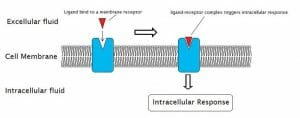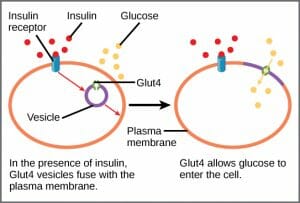Receptor Definition
A receptor is a protein which binds to a specific molecule. The molecule it binds is known as the ligand. A ligand may be any molecule, from inorganic minerals to organism-created proteins, hormones, and neurotransmitters. The ligand binds to the ligand-binding site on the receptor protein. When this binding happens, the receptor undergoes a conformational change. This change is shape slightly alters the protein’s function. From this, a number of things can happen. The conformational change in the receptor can cause the receptor to become an enzyme and actively combine or separate certain molecules.
The change can also cause a series of changes in related proteins, eventually transferring some sort of message to the cell. This message could be a metabolic regulation message, or it could be a sensory signal. The receptor has a certain capacity to hold onto the ligand, known as the binding affinity. Once this attraction wears out, the receptor will release the ligand, undergo a change to the original shape, and the message or signal will end. The speed of this turnover depends on the strength of the affinity between receptor and ligand.
Other molecules can also attach to the ligand-binding site on a receptor. These are called agonist molecules if they mimic the effect of the natural ligand. Many drugs, both prescription and illegal, are synthetic agonists to molecules like endorphins, which create feelings of satisfaction. However, these molecules often have a stronger affinity for the receptor than the natural ligand does. This means the agonist will stay attached to the receptor longer, which is why tolerances develop to certain drugs and painkillers. To get the same number of nerves firing when so many are already blocked by the drug requires a much higher dosage.
Still other molecules can act like antagonists, or molecules which block the ligand binding site on the receptor but do not allow the receptor to undergo a conformation change. This blocks a signal entirely. Some receptor antagonists include drugs which are used to wean people off of heroin and alcohol dependency. These act by making the use of the drug no longer pleasurable. Other antagonists include certain proteins in snake venom which mimic platelet binding proteins. The receptors which would normally connect platelets and prevent bleeding are therefore disabled. This can lead to internal bleeding and death. Pharmaceutical companies are interested in both agonists and antagonists for their potential to create effective medicines.
Types of Receptors
There are literally thousands of different types of receptors in the mammalian body. While there are far too many to start listing out, receptors do fall into some very broad categories of function. Many are used in “cellular signaling”, which is an enormously complex system of signals and responses mediated almost entirely by receptors and the ligands they receive. These include receptor proteins embedded in the cellular membrane which activate other sequences upon receiving a ligand, and the receptors found in the immune system which are structured to find intruding proteins and molecules. Below is the general model for cell signaling, which can take many different forms.
Another type of receptor is the gated ion channel, which opens a special passage upon the attachment of a ligand and allows ions to flow freely across the membrane. Because of this action, the electrical voltage which is maintained across the membrane is lost, and the region becomes depolarized. When large areas of cells like neurons are depolarized, an action potential is generated. This travels down the nerve as an electrical signal. At the end of the neuron, neurotransmitters are released, which act as ligands on the receptors of the next nerve cell. In this way, the signal travels quickly throughout the body and is based on the action and reversibility of receptor proteins.
Still other receptors have a high affinity for their ligand, and are used in functions such as binding the cell to the extracellular membrane and other cells. These receptor proteins still change shape when their ligand is bound, signaling to the cell that it is in contact with other cells. Different organisms use this in different ways. Multi-cellular animals use this to orient their cells and ensure the connections between them. Single-celled organisms may use these receptors to signal a defense mechanism or other action when space becomes too crowded. Many receptor proteins are ubiquitous among animals, as they have been conserved throughout evolution due to their extreme usefulness.
Examples of a Receptor
The Insulin Response
Insulin is an extremely important hormone which helps regulate the amount of glucose in the blood. Glucose is the main fuel for cells, but it needs a special transport molecule, Glut4, to help it enter the cell. Observe the image below.
As blood glucose levels increase, special receptors in the pancreas sense this, and begin producing and releasing insulin into the blood stream. Nearly all cells in the body have insulin receptor proteins. When these receptor proteins contact insulin, it binds to the ligand-binding location on the receptor protein. This causes a conformational change in the protein. This change in the receptor sets off a series of other reactions triggered by associated proteins. These proteins create a messenger molecule which affects the movement of Glut4 to the cell membrane. While insulin is present, this happens quickly. The vesicles holding Glut4 fuse to the membrane, bind glucose, and transport it into the cell. When insulin disappears, this stops insulin production and shuts off uptake of glucose. Not only is the insulin receptor protein involved, but a number of other receptors used in associated reactions and other cells. As can be seen, the role of a receptor can become quite complicated.
Taste Response
A different type of receptor can be seen in the example of a taste nerve. Parts of the nerve project into the mucous membrane of the mouth. As sugar, salt, or other molecules are eaten, they dissolve into the saliva and are distributed throughout the mucous membrane. Each of these ligands has different cells containing receptors specific to it. These receptors are gated ion channels, like in a nerve cell. When a ligand attaches to them, they allow ions to pass through the membrane. This causes an area of the membrane to depolarize. If there is enough ligand molecules, many receptors will be activated at one, causing an action potential.
This wave of depolarization will move down the nerve cell until it reaches the other side. Once there, special capsules containing neurotransmitters are burst by the action potential, releasing the ligands into the space between nerves. The receptors and the next nerve receive the ligand, and the process starts over. This happens several times between the tongue and the brain. The signal finally reaches processing centers in the brain, and the “sweet” taste is comprehended. This all happens in fractions of a second.
Quiz
1. Which of the following is a receptor?
A. A protein which lowers the activation energy of a reaction if a substrate is present
B. A protein which accepts a ligand, causing a sequence of other reactions
C. A structural protein which does not bind to other molecules
2. Which of the following is NOT a task of receptors?
A. Receiving a ligand
B. Transferring a signal
C. Storing energy
3. A pharmaceutical company is developing a new drug. The drug is an antagonist for pain receptors, and blocks the feeling of pain. The drug works, but the company is concerned that the drug’s affinity for the receptor is too high. Why is this a concern?
A. It is not a concern
B. A high affinity means people will only need to buy one dose
C. The drug may stay attached to the receptor
References
- Lodish, H., Berk, A., Kaiser, C. A., Krieger, M., Scott, M. P., Bretscher, A., . . . Matsudaira, P. (2008). Molecular Cell Biology (6th ed.). New York: W.H. Freeman and Company.
- Nelson, D. L., & Cox, M. M. (2008). Principles of Biochemistry. New York: W.H. Freeman and Company.
- Widmaier, E. P., Raff, H., & Strang, K. T. (2008). Vander’s Human Physiology: The Mechanisms of Body Function (11th ed.). Boston: McGraw-Hill Higher Education.
Receptor


No comments:
Post a Comment